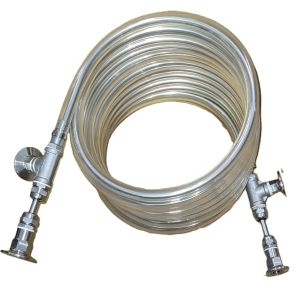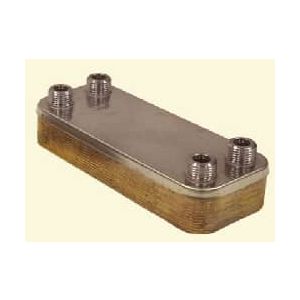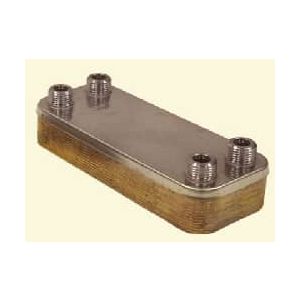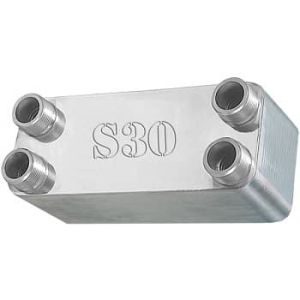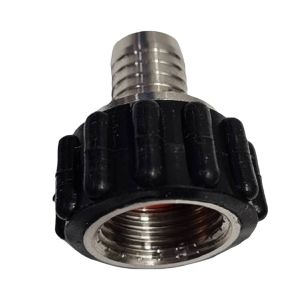Wort Chillers - Immersion and Counterflow

- Immersion Wort Chiller - S30£81.00 £67.50
- Plate Wort Chiller 41 Plate£92.70 £77.25
- 40 Plate Wort Chiller with 1/2" Barb Fittings£91.20 £76.00
- 60 Plate Wort Chiller with 1/2" Barb Fittings£123.60 £103.00
- Tri Clamp Counter Flow Wort Chiller - Stainless Steel£120.00 £100.00
- CounterFlow Wort Chiller 12 plate£75.60 £63.00
- CounterFlow Wort Chiller 36 plate£126.00 £105.00
-
-
- 1/2" Stainless Steel Wort Chiller Kit£76.50 £63.75
- Stainless Steel Immersion Wort Chiller 3/8" Tube£53.04 £44.20
- Brass 3/4" x 1/2" Fitting with Barb£3.60 £3.00
-
What are Wort Chillers
If you're a homebrewer or a beer enthusiast, you might have heard of the term "wort chiller." But what exactly is a wort chiller and why is it important in the brewing process?
In brewing, wort is the liquid extracted from the mashing process, which contains the sugars that will be fermented to produce alcohol. After boiling the wort with hops, it needs to be cooled down to a specific temperature before adding the yeast. This is where wort chillers come in.
A wort chiller is a device that rapidly cools down the hot wort to a temperature suitable for fermentation. There are two main types of wort chillers: immersion and counterflow.
Immersion wort chillers are the most common type used by homebrewers. They consist of a coil of copper tubing that is submerged in the hot wort. Cold water is then run through the tubing, which cools down the wort as it flows through.
Counterflow wort chillers, on the other hand, use two separate tubes to cool down the wort. The hot wort flows through one tube while cold water flows in the opposite direction through another tube, which cools down the wort as it passes through.
Using a wort chiller has several benefits. Firstly, it helps prevent contamination of the wort by rapidly cooling it down and reducing the risk of bacterial growth. It also helps to improve the clarity of the beer by causing proteins and other sediment to drop out of the wort. Additionally, cooling down the wort quickly can help to preserve the hop aroma and flavour in the finished beer.
In conclusion, wort chillers are an essential tool for any homebrewer or commercial brewery. They help to improve the quality and consistency of the beer by rapidly cooling down the hot wort and reducing the risk of contamination. Whether you choose an immersion or counterflow
Importance of Using a Wort Chiller in Homebrewing
Homebrewing is a fun and exciting hobby for many beer enthusiasts. However, it can also be a challenging and time-consuming process. One of the most important steps in brewing beer is cooling the wort after boiling. This is where a wort chiller comes in handy.
Using a wort chiller also helps to improve the clarity of the beer. When the wort is cooled quickly, it causes proteins to coagulate and settle out of the beer. This results in a clearer and more visually appealing beer. Additionally, rapid cooling helps to reduce the amount of time that the beer spends in the "danger zone" temperature range, where bacteria can thrive.
There are two main types of wort chillers: immersion and counterflow. Immersion chillers are coils of copper or stainless steel that are placed directly into the boiling wort. Cold water is then circulated through the coils, which rapidly cools the wort. Counterflow chillers, on the other hand, are made up of two tubes that are placed inside each other. The hot wort is pushed through the inner tube, while cold water is circulated through the outer tube in the opposite direction. This allows for even faster cooling times.
Investing in a wort chiller is a wise choice for any homebrewer. Not only does it save time and effort, but it also helps to improve the quality and clarity of the beer. So, if you're serious about brewing great beer at home, consider adding a wort chiller to your equipment list.
Types of Wort Chillers
When it comes to homebrewing, chilling the wort is an essential step to achieving a great tasting beer. A wort chiller is a tool that helps to cool down the wort quickly after boiling, which is crucial for achieving the desired flavours and aromas. There are several types of wort chillers available on the market, each with its own unique features and benefits.
Immersion Wort - Chiller
Immersion wort chillers are the most common type of wort chiller used by homebrewers. They typically consist of a long copper or stainless steel coil that is placed directly into the wort. Cold water is then circulated through the coil, which helps to cool down the wort quickly. Immersion wort chillers are easy to use and relatively inexpensive, making them a great option for beginners.
Counterflow Wort Chillers
Counterflow wort chillers work by pumping hot wort through a tube that is surrounded by cold water. This creates a counterflow of liquid, which helps to cool down the wort quickly. Counterflow wort chillers are more efficient than immersion chillers and can cool down the wort more quickly. However, they are also more expensive and can be more difficult to clean.
Plate Wort Chillers
Plate wort chillers are another type of wort chiller that is becoming increasingly popular among homebrewers. They work by passing hot wort through a series of plates that are stacked on top of each other. Cold water is then circulated on the other side of the plates, which helps to cool down the wort quickly. Plate wort chillers are very efficient and can cool down the wort very quickly. However, they are also the most expensive type of wort chiller and can be difficult to clean.
Wort Chiller Conclusion
No matter which type of wort chiller you choose, the most important thing is to make sure that you cool down your wort quickly after boiling. This will help to preserve the flavours and aromas of your beer and ensure that it tastes great. Whether you are a beginner or an experienced homebrewer, investing in a good wort chiller is a worthwhile investment that will pay off in the final product.
Best Practices for Using a Wort Chiller
If you're a homebrewer, you know that chilling your wort quickly after boiling is essential to making great beer. A wort chiller is a valuable tool that can help you achieve this goal. Here are some best practices for using a wort chiller:
1. Sterilise your equipment: Before using your wort chiller, make sure it's clean and Sterilised. You don't want any bacteria or other contaminants to ruin your beer.
2. Choose the right type of wort chiller: There are two main types of wort chillers: immersion chillers and counterflow chillers. Immersion chillers are easier to use and clean, but counterflow chillers are more efficient at cooling your wort.
3. Use the right amount of water: The amount of water you use to cool your wort will depend on the size of your batch and the type of chiller you're using. As a general rule, you'll need about five gallons of water to cool a five-gallon batch of wort.
4. Stir the wort: While you're chilling your wort, be sure to stir it gently. This will help to distribute the heat evenly and speed up the cooling process.
5. Monitor the temperature: Use a thermometer to monitor the temperature of your wort as it cools. You want to cool it down to around 70 degrees Fahrenheit before transferring it to your fermenter.
6. Be patient: Cooling your wort can take some time, especially if you're using an immersion chiller. Be patient and wait until your wort has reached the desired temperature before transferring it to your fermenter.
By following these best practices, you can ensure that your wort is properly chilled and ready for fermentation. A wort chiller is a great investment for any homebrewer, and with a little practice, you'll be able to use it like a pro.
How to Properly Clean and Maintain a Wort Chiller
A wort chiller needs proper cleaning and maintenance to function effectively and last for a long time.
The first step in cleaning your wort chiller is to rinse it with hot water immediately after use. This will help to remove any residual wort and prevent it from drying and hardening on the surface. Next, you can use a soft sponge or cloth and a mild detergent to clean the chiller. Avoid using harsh chemicals, abrasive sponges, or steel wool, as they can scratch or damage the surface of the chiller.
Once you have cleaned the chiller, rinse it thoroughly with hot water to remove any soap residue. Then, Sterilise it with a no-rinse sanitizer, such as Star San or iodophor, following the manufacturer's instructions. This will help to kill any remaining bacteria or yeast that may have survived the cleaning process.
In addition to regular cleaning and Sterilising, it's important to inspect your wort chiller periodically for any signs of wear and tear. Check the tubing for cracks or leaks, and make sure the fittings are tight and secure. If you notice any damage or corrosion, replace the affected parts before using the chiller again.
Finally, when storing your wort chiller, make sure it is completely dry and free of any moisture. Moisture can lead to rust or mold growth, which can affect the performance and safety of the chiller. You can use a soft cloth or towel to dry the chiller, or leave it to air dry for a few hours before storing it in a dry, cool place.
In conclusion, cleaning and maintaining your wort chiller is essential for producing high-quality homebrewed beer. By following these simple steps, you can ensure that your chiller remains in good condition and performs effectively for years to come.





